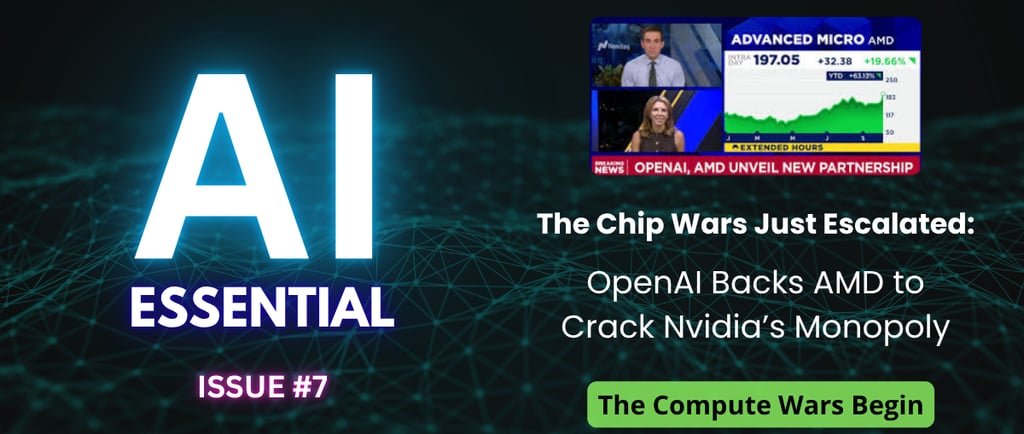The AI Chip Wars Just Escalated: OpenAI Backs AMD to Crack Nvidia’s Monopoly
OpenAI just bet big on AMD and made them Nvidia's first real competitor — with a multi-gigawatt deal and up to 10% equity on the table. This week's AI Essential breaks down why it matters and how to apply the lessons.
AI ESSENTIAL
Eric Wabrick
10/6/20252 min read


AI Essential – Issue #7
The one AI story that matters this week—
OpenAI and AMD just announced a multi-year, multi-gigawatt partnership securing up to 6 GW of compute capacity — and giving OpenAI the option to acquire up to 10% of AMD stock through performance-based warrants.
It’s the biggest power shift in AI hardware since ChatGPT launched. For the first time, Nvidia faces a credible challenger — and OpenAI just became a power broker in the compute economy.
AMD’s stock jumped 35% on the news. The market’s verdict: the AI infrastructure race is now officially a two-horse race.
Key Insights
1. Compute Is the New Oil — and OpenAI Just Secured Supply
This deal cements compute — not models — as the true bottleneck of progress. OpenAI already committed 4.5 GW to Oracle; now it’s adding 6 GW with AMD. That’s 10+ GW of total capacity, more power than many small countries consume. Whoever controls GPU capacity controls innovation velocity — and OpenAI just diversified its supply chain while gaining serious leverage.
2. Equity Is the New Alignment
By taking up to 10% ownership in AMD, OpenAI isn’t just buying chips — it’s buying influence. Milestone-based equity ties both companies’ futures together, aligning incentives around scalability and resilience rather than one-off procurement. Expect more of these hybrid deals as AI firms lock in compute and hedge supply risk.
3. Infrastructure Is Where the Value Flows
While AI startups burn billions training models, the companies selling compute keep minting profits. Nvidia, Microsoft, Oracle, and now AMD have added trillions in market cap since ChatGPT’s debut. The pattern is clear: in every gold rush, the picks and shovels win first. The real battle has moved below the software layer — to where compute, energy, and chip efficiency converge.
4. The Hardware Layer Is Now Strategic Ground
Access to cheap, reliable power and diverse chip partnerships is becoming a competitive moat. The companies that secure compute early will own the next decade of AI. This isn’t just about chips — it’s about energy deals, vendor leverage, and who controls the foundation of intelligence itself.
Why It Matters & How to Apply It
We’re entering the Intelligence Economy — where access to compute defines competitive advantage.
For business leaders:
Don’t get locked into one vendor. Flexibility equals resilience. Think about compute and energy as core to your AI strategy — not afterthoughts.
For investors:
Infrastructure remains the safest bet. While model builders face uncertain revenue paths, chip and cloud providers are securing decade-long contracts. Follow the power — not the hype.
For AI companies:
Build for efficiency. Design workflows that reduce GPU dependence. The winners won’t just use AI — they’ll control the stack that powers it.
The Bottom Line
OpenAI’s deal with AMD isn’t just about chips — it’s about power: energy, compute, and leverage.
Nvidia still dominates. But today, the monopoly cracked. And the companies that control compute infrastructure will define the next decade of AI — not just the ones building models.
---
⚡ Want to explore how these AI shifts affect your business? → Book a Free Strategy Call
Connect
Explore our social media pages
Contact
Newsletter
724-801-1234
© 2025. All rights reserved.
